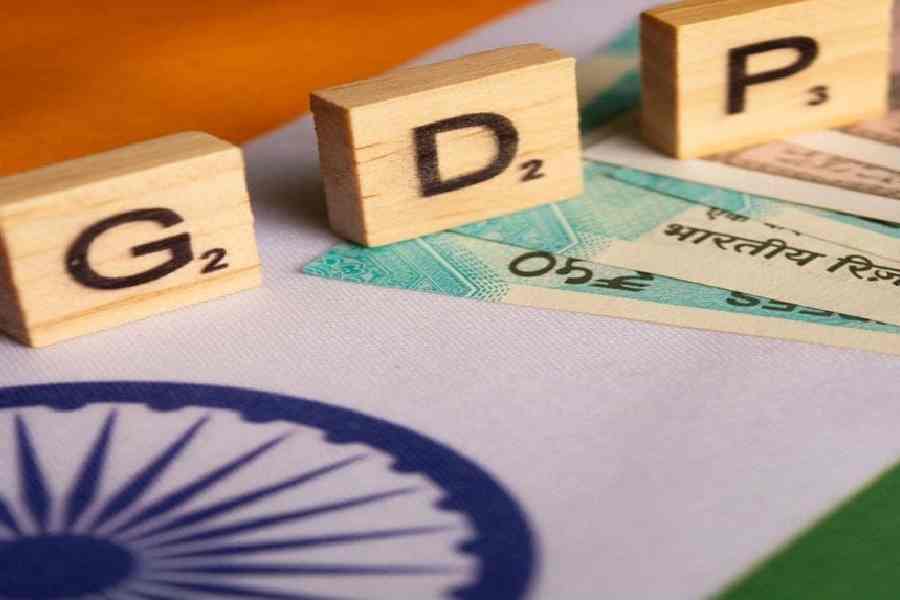Economic growth slowed to a five-quarter low of 6.7 per cent in the April-June quarter (Q1), mainly because of a decline in government spending during the national elections.
Economists have expressed concern about the potential for further slowdown if infrastructure spending does not pick up significantly.
The gross domestic product (GDP) expanded 8.2 per cent in the April-June quarter of 2023-24. The previous low of 6.2 per cent was recorded in the January-March quarter of 2023. The economy grew 7.8 per cent in the fourth quarter of last fiscal.
Chief economic adviser V. Anantha Nageswaran on Friday said the economy was on its way to achieve 6.5-7 per cent growth in the current fiscal.
“In the first quarter data, there is a clear message that the government of India should accelerate its infrastructure spending to make up for the negative growth in its capital expenditure in the first four months,” said D.K. Srivastava, chief policy adviser at EY India and a member of the advisory council to the 16th Finance Commission.
“Unless this is made up and converted into a positive annual growth of 17 per cent or above, the likelihood is that the annual real GDP growth may fall below 7 per cent.”
Ankita Amajuri, assistant economist, CapitalEconomics, said she expected the economy to cool a bit further over the coming quarters as household consumption moderates and investment growth eases in an environment of still-high interest rates.
“But the economy is not going to crater. Timely data such as the PMIs remain consistent with healthy growth and the expanded public infrastructure drive is likely to continue supporting activity. The economy is still on track to grow 6.5 per cent this year,” she said.
Despite the slowdown, some economists remain optimistic about India’s economic prospects.
The agriculture sector’s gross value added (GVA) growth decelerated to 2 per cent from 3.7 per cent in the first quarter of the fiscal year.
GVA growth in the manufacturing sector accelerated to 7 per cent compared with 5 per cent a year ago.
The NSO nominal GDP or GDP at current prices in the first quarter of 2024-25 is estimated at ₹77.31 lakh crore against ₹70.50 lakh crore a year ago, showing a growth rate of 9.7 per cent.
Trade, hotels, transport, communication and services related to broadcasting slowed to 5.7 per cent from 9.7 per cent a year ago.
Private final consumption expenditure (PFCE) accelerated to a seven-quarter high of 7.4 per cent in Q1 from 4 cent in the previous quarter.
“We had expected a recovery in private consumption based on a pickup in rural demand manifested through high-frequency indicators such as two-wheeler sales but the extent is higher than our expectations at 7.4 per cent on an annual basis,” said Suman Chowdhury, executive director and chief economist, Acuite Ratings & Research.
According to Dharmakirti Joshi, chief economist, Crisil, although overall private consumption shows mixed trends in the first quarter, initial signs of pick up in rural consumption are visible.
“We expect private consumption demand to improve this year over an anaemic growth of 4 per cent in fiscal 2024,” Joshi added.
Icra chief economist Aditi Nayar pointed to the acceleration in GVA growth on a sequential basis.
“This divergent trend was led by the normalisation of the growth in net indirect taxes, and the slowdown in the GDP growth is not a cause for alarm.”
Core growth
The core sector growth, comprising eight key infrastructure industries, slowed to 6.1 per cent in July because of a decline in crude oil and natural gas production.
While this represents an improvement from the 5.1 per cent growth recorded in June, it falls short of the 8.5 per cent growth seen in July 2023.
Fiscal deficit at the end of the first four months of the current fiscal touched 17.2 per cent of the full-year target.











